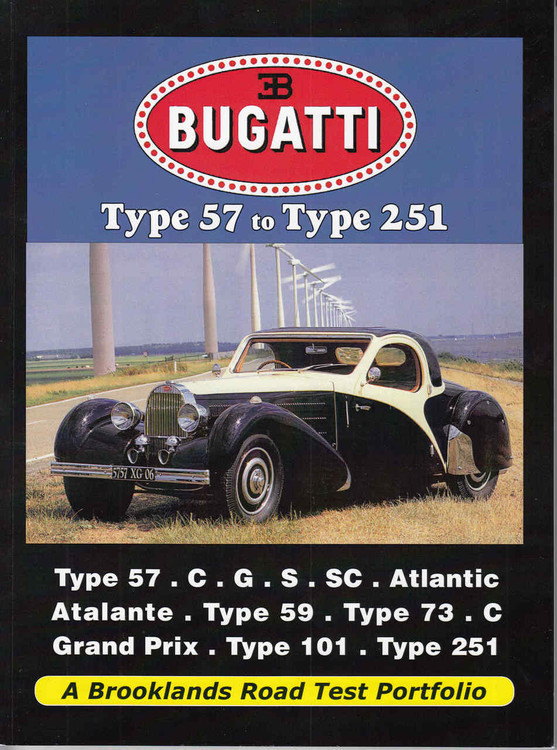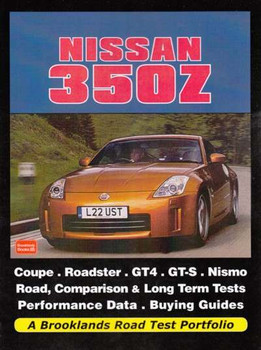Description
Brooklands Books, Compiled by R.M.Clarke, A-BUG3RP, Softbound, 160 Pages, ISBN: 9781855208711
- Type 57 - C - G - S - SC - - Atlantic - Atalante - Type 59 - Type 73C - Grand Prix - Type 101 - Type 251
This, our third Bugatti portfolio, traces the final years of production starting with Jean Bugatti's newly designed Type 57. Included are new model introductions and updates, road tests, full specifications and performance data plus historical features and classic 'salons'.
Reported on are the Type 57-c-g-s-sc, Atlantic, Atal ante, Type 59, Type 73-c, Grand Prix, Type 101 and the futuristic Type 251.
A total of 160 fully illustrated pages
Brooklands
Our thanks go once more to our friends at Wikipedia for this time listing and explaining later Bugatti models Type 57 through Type 251.
The Type 57 and later variants (including the famous Atlantic and Atalante models) were of an entirely new design by Jean Bugatti, son of founder Ettore. A total of 710 were built between 1934 and 1940. Most Type 57s used a twin-cam 3257cc engine based on that of the Type 49 but heavily modified by Jean Bugatti. Unlike the chain-drive twin-cam engines of the Type 50 and 51, the 57's engine used gears to transmit power from the crankshaft.
The original Type 57 was a touring car model produced from 1934 to 1940. It used the 3.3L (3257cc; 198cu in) engine from the Type 59 Grand Prix cars, producing 135hp (100kW). Top speed was 95 miles per hour (153k_m/h). It rode on a 130-inch (3,302mm) wheelbase and had a 53.1-inch (1,349mm) wide track. Road-going versions weighed about 2,100 pounds (950kg). Hydraulic brakes replaced the cable-operated units in 1938, a modification Ettore Bugatti hotly contested. Some 630 examples were produced. The original road-going Type 57 included a smaller version of the Royale's square-bottom horseshoe grille. The sides of the engine compartment were covered with thermostatically-controlled shutters. It was a tall car, contrary to the tastes of the time.
The Type 57G the famous tank-bodied racers used the 57S chassis in 1936 and 1937 and the 57C for 1939.
The Type 57T Tourer was a "tuned" Type 57 with increased performance.
The Type 57C was a racing car was built from 1937 to 1940, with nearly 750 produced. It shared the 3.3L engine from the road-going Type 57 but produced 16hp (11 kW) with a Roots-type supercharger fitted.
Type 57C Tank won the 1936 French Grand Prix, as well as the 1937 24 Hours Le Mans. It used a different 4.7L (4743cc 289cu in) engine.
The Type 57S/SC is one of the best-known Bugatti cars. The "S" stood for "surbaisse" ("lowered"), though most felt it stood for "sport". It included a v-shaped dip at the bottom of the radiator and mesh grilles on either side of the engine compartment. Lowering the car was a major undertaking. The rear axle now passed through the rear frame rather than riding under it, and a dry-sump lubrication system was required to fit the engine under the new low hood. The 57S had a nearly-independent suspension in front, though Ettore despised that notion. Just 43 "surbaisse" cars were built.
Type 57SC. Just two supercharged Type 57SC cars were built new, but most 57S owners wanted the additional power afforded by the blower. Therefore, most of the original Type 57S cars returned to Molsheim for the installation of a supercharger, pushing output from 175hp (130kW) to 200hp (150kW) and 120mph (190km/h).
The Atlantic was considered by some to be the most beautiful pre-war car, the Atlantic body Type 57S featured flowing coupe lines with a pronounced dorsal seam running front to back. It was based on the "Aerolithe" concept car of 1935. Like the Type 59 Grand Prix car, the Aerolithe used Elektron (magnesium, a combustible material) or Duralumin (aluminium) for its body panels. Therefore, the body panels were riveted externally, creating the signature seam. The production At!antics (just four were made) used plain aluminium, however. But the dorsal seams were retained for style, and have led to the car's present fame.
The Type 57S45 used a 4743 cc engine like the Tank. Another Tank, this time based on the "surbaiss6" Type 57S, won Le Mans again in 1939. Shortly afterwards, Jean Bugatti took the winning car for a test on the Molsheim-Strasbourg road. Swerving to avoid a drunken bicyclist on the closed road, Bugatti crashed the car and died at age 30.
The Atalante was a two door coupe body style similar to and built after the Atlantic, built on both the Type 57 and 57S, but with a single piece windscreen and no fin. Only 17 Atalante cars were made.
The Type 59, the final Bugatti race car of the 1930s was the Type 59 of 1934. It used an enlarged 3 .L (3257cd198in3) version of the straight-8 Type 57's engine sitting in a modified Type 54 chassis. The engine was lowered for a better center of gravity, and the frame was lightened with a number of holes drilled in the chassis. The signature piano wire wheels used splines between the brake drum and rim, and relied on the radial spokes to handle cornering loads. 250hp (18kW) was on tap, and 6 or 7 were made.
The Type 64 was an Atlantic-style coupe produced in 1939. It was fitted with a 4.4L (4432cc/270 in3) 2-valve DOHC straight-8 engine and rode on a 130in (3300mm) wheelbase. It was not produced in volume.
Tbe Type 73C begun in 1943 and completed in 1947 after the war, the Type 73C was to be the comeback car for Bugattd. But the death of Ettore Bugatti that year doomed the project. An engine-less Type 73 was shown at the 1947 Paris Motor Show two months later. Although five 73C chassis had been constructed in Paris. Only one body was completed for these cars and at least three engines and one complete car were assembled and tested by the factory. Serge Pozzoli stated that he visited the Bugatti factory at Rue Debarcadere in Paris where he saw a demonstration car which was fitted with a scaled down body similar to the pre-war Type 50BIII (Cork Car).
All the cars were dismantled and taken to Molsheim after Ettore Bugatti's death. The Type 73C used a new1.5L (1488cc190in3) straight-4 engine with 4 valves per cylinder and a twin overhead camshaft. This was a new design with a 76mm bore and 95mm stroke, wet cylinder liners, a detachable cylinder head, and a single cast iron exhaust manifold. Much to the chagrin of Bugatti purists, the Type 73 used off-the-shelf hex fasteners rather than the custom-designed parts used in all previous cars.
The five Type 73C chassis were sold off after the company exited automobile production. Most were later assembled, and one (number 2) was even given a body based on the original Bugatti drawings. This car sold at auction in 2002 for just over US$100,000, the low price reflecting die lack of interest in the incomplete car.
There are several prototype Type 73 Bugatti models:
Type 73: Touring two or four seater; four cylinder, twin overhead camshaft, four valves per cylinder Type 73A: Touring two or four seater four cylinder Single overhead camshaft with three valves per cylinder. Type 73C: Grand Prix single seater: The engine fitted to this car is similar to the Type 73
Type 73B: Touring two or four seater: Similar engine to the Type 73 but with single overhead camshaft.
The Type 101. In order to restart Bugatti, a new car was needed for the 1950s. The result was the 1951 Type 101. An evolution of the Type 57, it is considered by many to be the last true Bugatti car, with just seven produced in 1956. Powered by the 3.3L (3257cc/198in3) straight-8 from the Type 57. The seven chassis were bodied by four different coachbuilders: Gangloff, Guillore, Antem, and Virgil Exner/Ghia.
The last Type 101 was built in 1965 by Ghia designed by Virgil Exner for the last remaining Type 101 chassis as an attempt to revive the marque. It was exhibited at the Turin Motor Show, but financing could not be arranged and production plans were scrapped. Exner owned the car for many years, and it has lately appeared in public at the Pebble Beach Concours d'Elegance.
The Type 251. The final resurgence of the original Bugatti was the Type 251, completed in 1955. Designed by Gioacchino Colombo of Ferrari fame, it was powered by a new 2.5L (2486cc/151in3) straight-8. Uniquely, this engine was mounted transversely, behind the driver. For the first time in a Bugatti, an oversquare engine was used with a 76mm bore and 68.5mm stroke. A de Dion tube rear suspension was also a novelty for the company, though it was in vogue at the time.
The Type 251 was entered in the 1956 French Grand Prix, driven by Maurice Trintignant, but was not competitive and retired after 18 laps. The Bugatti Type 252 was a sports car produced by Bugatti between 1957 and 1962. It never went beyond a prototype.





















